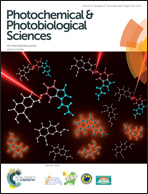A theoretical exploration on electronically excited states of protonated furan and thiophene†
Abstract
The geometry, electronic structures and potential energy profiles of protonated furan and thiophene have been extensively investigated, using the RI-MP2 and RI-CC2 methods. According to RI-CC2 calculated results, the adiabatic S1(1ππ*)–S0 transition energies of protonated furan and thiophene, have been predicted to be 4.41 eV and 3.70 eV respectively. Thus, protonation is accompanied by a large red shift effect on the first 1ππ* transition of the title systems (ΔE > 1.5 eV). The significant spectral-movements, predicted based on the calculated results of this work, indicate an essential effect of protonation on the geometry, electronic structures and optical characters of the five membered heterocyclic systems. In addition, it has been found that excitation of protonated furan and thiophene, with sufficient excess energy above the band origin of S1(1ππ*)–S0 transition, is accompanied by the S–C or O–C bond breaking. This mechanism is mostly governed by a dissociative 1πσ* PE profile in both protonated systems.



 Please wait while we load your content...
Please wait while we load your content...